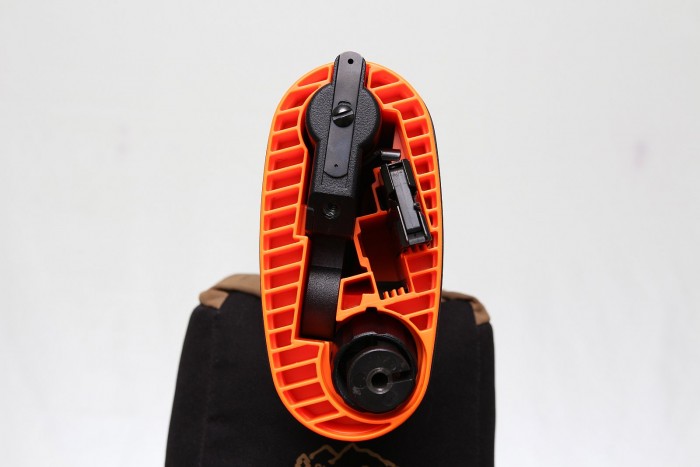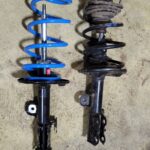Henry US Survival Rifle (AR-7)
Another niche rimfire rifle. While the Henry U.S. Survival Rifle is similar in price to the Henry Classic Lever Action 22, the design reflects a completely different purpose. The Armalite AR-7 Explorer that the Henry is based on was originally designed as a pilot’s survival weapon. Packed away in its floating buttstock, delicate mechanisms and sights are well coddled. This thing could survive a plane crash that would render most other lightweight 22’s into scrap.
I don’t think the majority of Henry US Survival Rifle buyers are putting it into an airplane, so I’ll be reviewing it as a backpack/quad/canoe 22 that one could use to take small game like grouse where local game regulations allow it. The Henry Survival Rifle goes for $249 in the US and $369 in Canada.
Video Review
Assembly/Disassembly
If you own a Survival Rifle and use it fairly often, you’ll probably be disassembling and reassembling it often. Luckily, it’s very well designed and easy to assemble or take down. To assemble:
- Remove the rear buttpad
- Remove the receiver, place it into the slot on the buttstock, and then fasten it down with the action screw. Get it tight enough where there isn’t any movement between buttstock and receiver.
- Remove the barrel, use the pin to align and insert it into the receiver. The bolt will bear against the barrel, so you’ll need to press it a bit to get it tight against the receiver. Tighten down the barrel nut.
- Remove magazines (1 in the gun, 1 in your pocket?), and put the buttpad back on.
As you can see, very easy. If you have this rifle and you need more, check out the images below, or my video review at 2:50.
Shooting the Henry U.S. Survival Rifle
This rifle is designed first and foremost for durability, compactness, and to float. Shootability suffers somewhat. The rear peep sight can move up and down but is fixed horizontally, while the bright orange front sight can be drifted side to side for windage adjustments. The charging handle is hard to grab to pull out, especially with winter gloves on and the barreled action is slightly offset to the right on the buttstock; it’s not centered because of where the barrel fits in the stock. The trigger is ridiculous out of the box, but works in a bit more once you’ve fired a few boxes of 22LR so that it’s only mildly stiff. The lack of a forend isn’t a huge deal, because the rifle is light as it is and balanced towards the rear; gripping it by the mag is enough.
In decent weather, my Henry Survival Rifle had no problem with ammo so long as it was round nose profile. Don’t use flat point or ammo with large hollow-points like Winchester 333 or you will get stoppages. In really cold weather (-30C or -22F), I had all sorts of stoppages. Fail to fire (firing pin wasn’t hitting the rim hard enough), failure to eject, and failures to feed. To be fair, that kind of weather is hard on all semi-automatic rimfires.
I found accuracy to be “good enough for the intended use”. At 25 yards, I got 1-2″ groups using the peep sight. Given that this rifle is to be used to take down grouse, squirrels, and other small game at ~25 yards, that accuracy is acceptable.
The safety is nice and quiet: big points in my books, especially for a rifle intended as a last-ditch survival rifle shooting squirrels to eat.
Build Quality
Here, design and cost were balanced. Lots of plastic and coating to keep things very weatherproof. The barrel, for example, is a thin steel unit sleeved with plastic and coated with teflon. The receiver is also coated. The high visibility front sight is nice and the buttstock insert that everything goes into is well fitted.
If I was looking to store my Survival Rifle for long periods, I would consider leaving a desiccant bag right in the buttstock to keep humidity off the metal parts, in addition to oiling metal parts like I would for any other rifle that’s going to sit.
Opinions
- The charging handle needs a detent so that it can be either in or out, not flopping about.
- Why is this thing offered in black and camo? It should be offered in a bright color to make it easy to find in an airplane wreck or floating on the surface of the water after your canoe tips over.
- Skip the 3/8 dovetail mount and go straight to picatinny rail. That would make a quick detach mount red dot or other small sight possible. Quick detach rings for 3/8 dovetail are very hard to find.
- Fix the second magwell to make it hold mags as securely as the first. (the bottom mag well in mine held mags with a nice click, where the top kinda let them flop around)
- Include 3 mags instead of 2.
Summary
Let’s call a spade a spade: this rifle is designed as a survival rifle. It’s not designed as a daily shooter, as a gopher killer, or as a fun range gun. There are much better 22’s for those activities. But those 22’s don’t float, are bulky to fit into a canoe, airplane, or backpack, and wouldn’t survive much of an impact.






























